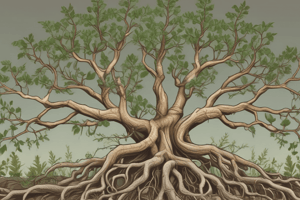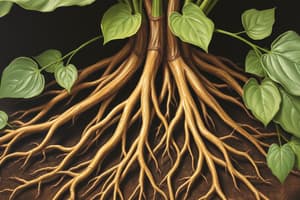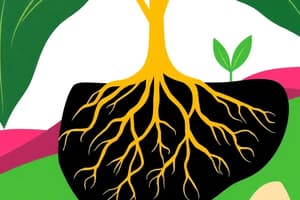Podcast
Questions and Answers
What is a primary role of the root zone of protection?
What is a primary role of the root zone of protection?
- Protects the root tip as it grows (correct)
- Produces new root cells
- Absorbs nutrients from the soil
- Facilitates the transport of water
Which of the following correctly identifies the function of xylem?
Which of the following correctly identifies the function of xylem?
- Movement of water and minerals (correct)
- Transporting organic nutrients
- Providing structural support
- Storage of sugars and starches
What type of tissue is involved in food storage within a plant?
What type of tissue is involved in food storage within a plant?
- Dermal tissue
- Vascular tissue
- Meristematic tissue
- Ground tissue (correct)
Which characteristic distinguishes dicots from monocots in terms of flower parts?
Which characteristic distinguishes dicots from monocots in terms of flower parts?
What occurs within the meristematic zone of the root?
What occurs within the meristematic zone of the root?
In terms of leaf venation, how do monocots differ from dicots?
In terms of leaf venation, how do monocots differ from dicots?
What is the primary function of dermal tissue in plants?
What is the primary function of dermal tissue in plants?
What defines tracheids compared to xylem vessels?
What defines tracheids compared to xylem vessels?
Why is the process of elongation significant in plant roots?
Why is the process of elongation significant in plant roots?
What is a main function of the root system beyond anchoring the plant?
What is a main function of the root system beyond anchoring the plant?
Which root zone is responsible for the differentiation of cells into various tissue types?
Which root zone is responsible for the differentiation of cells into various tissue types?
In the structure of xylem, which statement accurately reflects its function?
In the structure of xylem, which statement accurately reflects its function?
Which of the following is NOT a type of tissue produced in the differentiation zone of roots?
Which of the following is NOT a type of tissue produced in the differentiation zone of roots?
How does the structure of tracheids differ from xylem vessels?
How does the structure of tracheids differ from xylem vessels?
Which zone of the root is primarily responsible for the production of new cells?
Which zone of the root is primarily responsible for the production of new cells?
Which of the following best describes the leaf venation pattern in dicots?
Which of the following best describes the leaf venation pattern in dicots?
What function is specifically associated with ground tissue in plants?
What function is specifically associated with ground tissue in plants?
What is the significance of using a very thin section when examining plant tissues under a microscope?
What is the significance of using a very thin section when examining plant tissues under a microscope?
Which characteristic differentiates monocots from dicots regarding flower part arrangements?
Which characteristic differentiates monocots from dicots regarding flower part arrangements?
Flashcards are hidden until you start studying
Study Notes
Root Functions and Types
- Roots anchor plants in soil and absorb water.
- Two main types of roots: tap roots (deep, single main root) and fibrous roots (shallow, branching network).
Root Zones
- Four distinct root zones:
- Zone of differentiation: cell specialization into three types of tissues.
- Zone of elongation: cells increase in size to push deeper into the soil.
- Meristematic zone: area of active cell division producing new cells via mitosis.
- Zone of protection: root cap safeguards cells during soil penetration.
Tissue Types
- Three types of tissues formed in the differentiation zone:
- Dermal tissue: provides protection to the plant surface.
- Ground tissue: primarily involved in food storage.
- Vascular tissue: responsible for transportation of fluids; xylem transports water and minerals, while phloem carries food.
Stem Functions
- Stems support the aerial parts of the plant and can serve as food storage sites.
Leaf Functions
- Leaves are involved in photosynthesis (light energy conversion) and transpiration (water loss regulation).
Vascular Tissue Differences
- Xylem and phloem are distinct:
- Xylem: transports water and minerals.
- Phloem: transports food.
- Xylem vessels have straight ends, while tracheids have tapered ends.
Monocots vs. Dicots
- Monocots exhibit parallel leaf venation; dicots have netted venation.
- Flower parts in monocots occur in threes; in dicots, they occur in fours or fives.
Dicot Stem Observations
- Plant used for observation: Busy Lizzie.
- Dicotyledon refers to plants with two seed leaves.
- Thin sections are required for light to pass through when using a microscope.
- Sections are transferred to microscope slides using forceps.
- Safety during cutting is ensured by directing cuts away from the body with a scalpel.
Root Functions and Types
- Roots anchor plants in soil and absorb water.
- Two main types of roots: tap roots (deep, single main root) and fibrous roots (shallow, branching network).
Root Zones
- Four distinct root zones:
- Zone of differentiation: cell specialization into three types of tissues.
- Zone of elongation: cells increase in size to push deeper into the soil.
- Meristematic zone: area of active cell division producing new cells via mitosis.
- Zone of protection: root cap safeguards cells during soil penetration.
Tissue Types
- Three types of tissues formed in the differentiation zone:
- Dermal tissue: provides protection to the plant surface.
- Ground tissue: primarily involved in food storage.
- Vascular tissue: responsible for transportation of fluids; xylem transports water and minerals, while phloem carries food.
Stem Functions
- Stems support the aerial parts of the plant and can serve as food storage sites.
Leaf Functions
- Leaves are involved in photosynthesis (light energy conversion) and transpiration (water loss regulation).
Vascular Tissue Differences
- Xylem and phloem are distinct:
- Xylem: transports water and minerals.
- Phloem: transports food.
- Xylem vessels have straight ends, while tracheids have tapered ends.
Monocots vs. Dicots
- Monocots exhibit parallel leaf venation; dicots have netted venation.
- Flower parts in monocots occur in threes; in dicots, they occur in fours or fives.
Dicot Stem Observations
- Plant used for observation: Busy Lizzie.
- Dicotyledon refers to plants with two seed leaves.
- Thin sections are required for light to pass through when using a microscope.
- Sections are transferred to microscope slides using forceps.
- Safety during cutting is ensured by directing cuts away from the body with a scalpel.
Studying That Suits You
Use AI to generate personalized quizzes and flashcards to suit your learning preferences.




